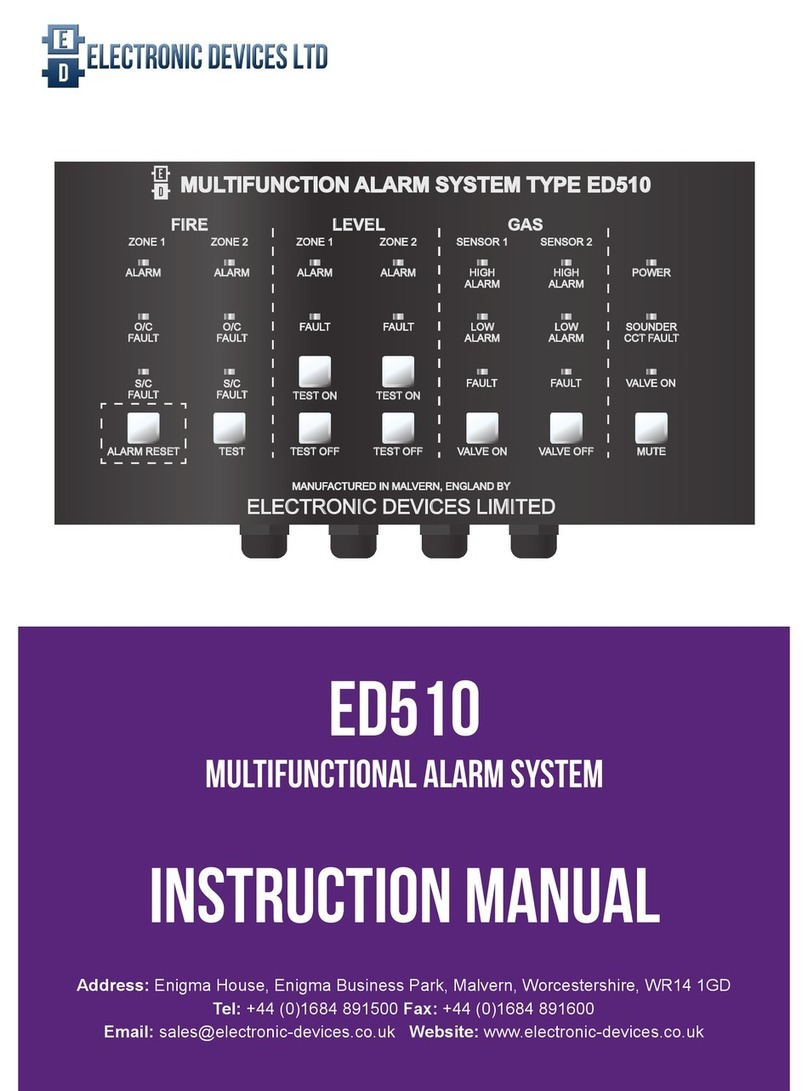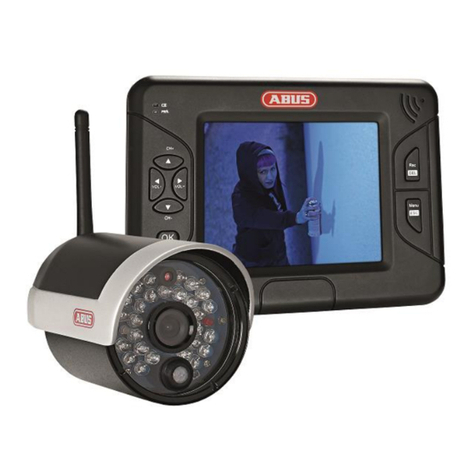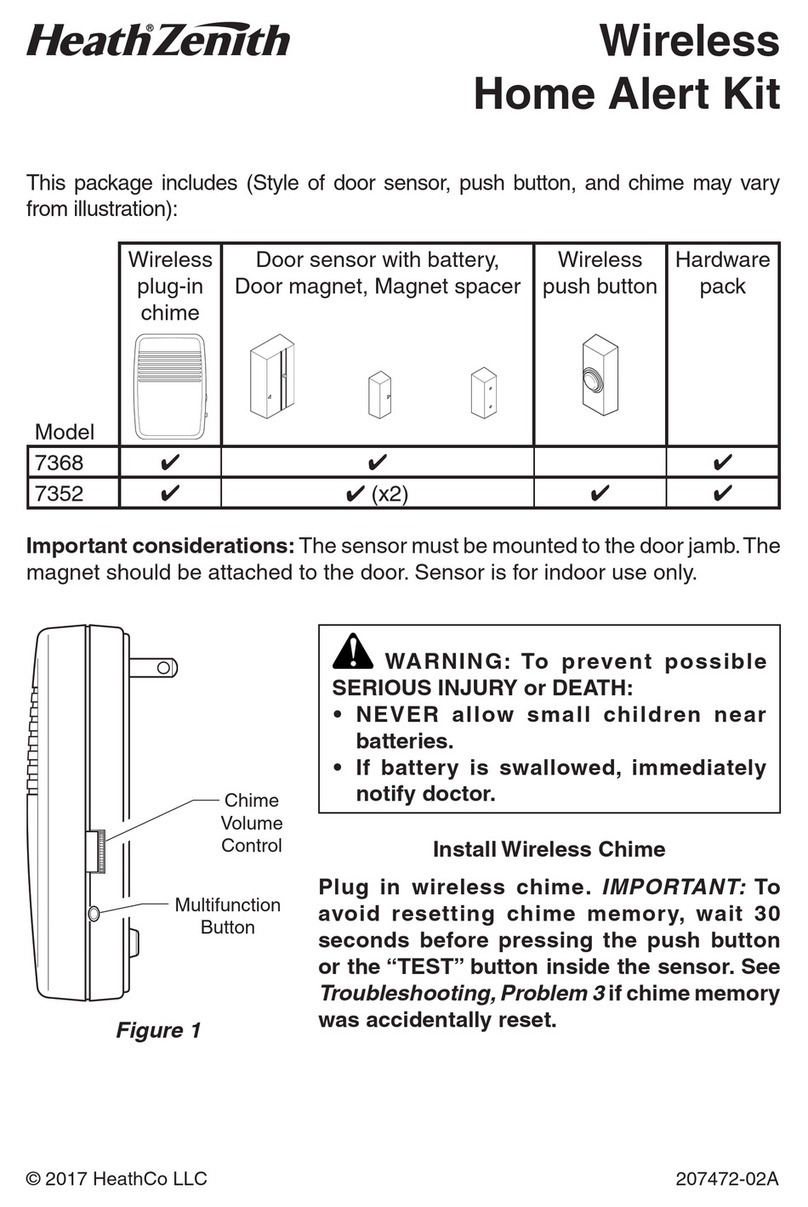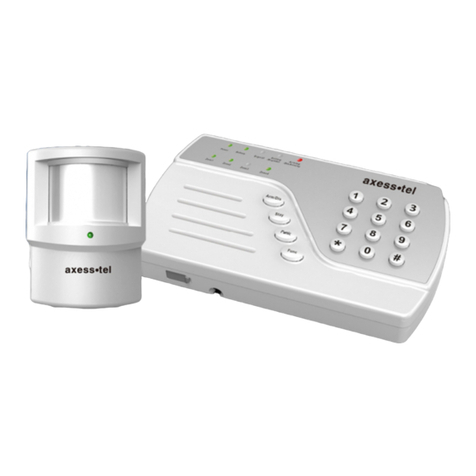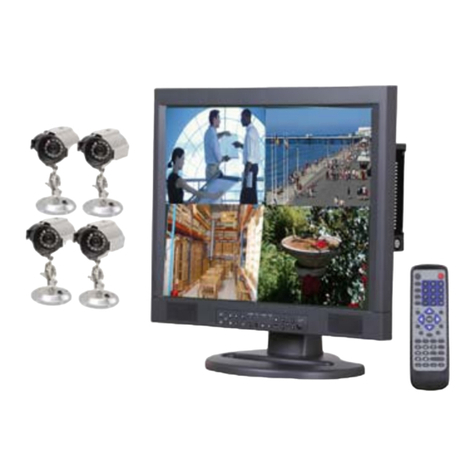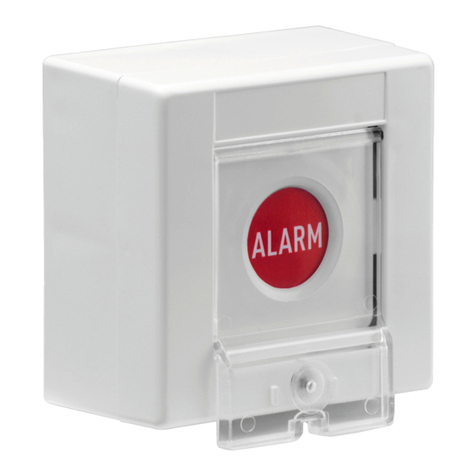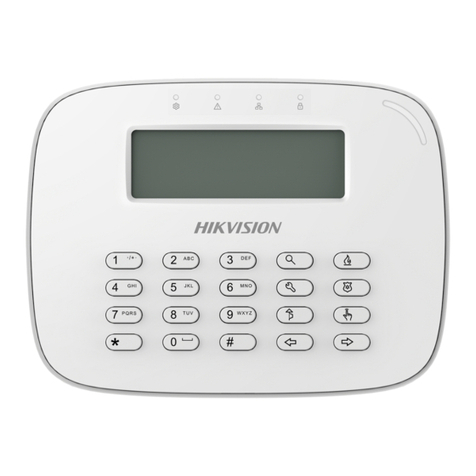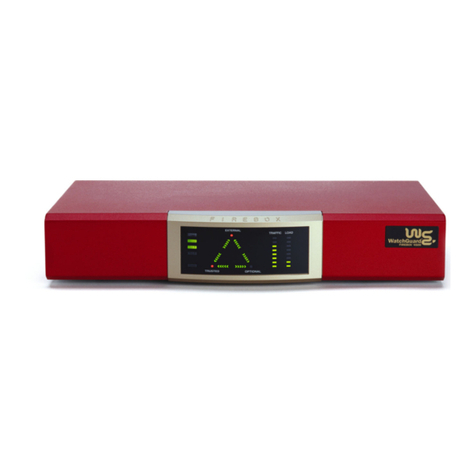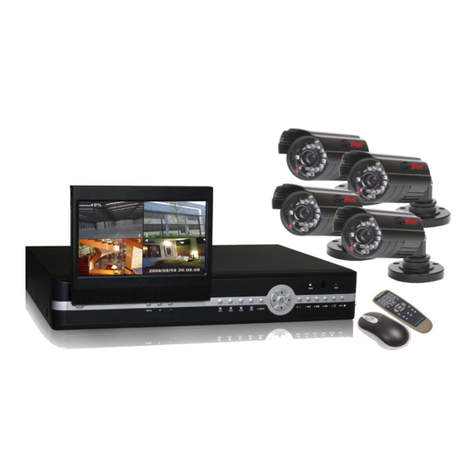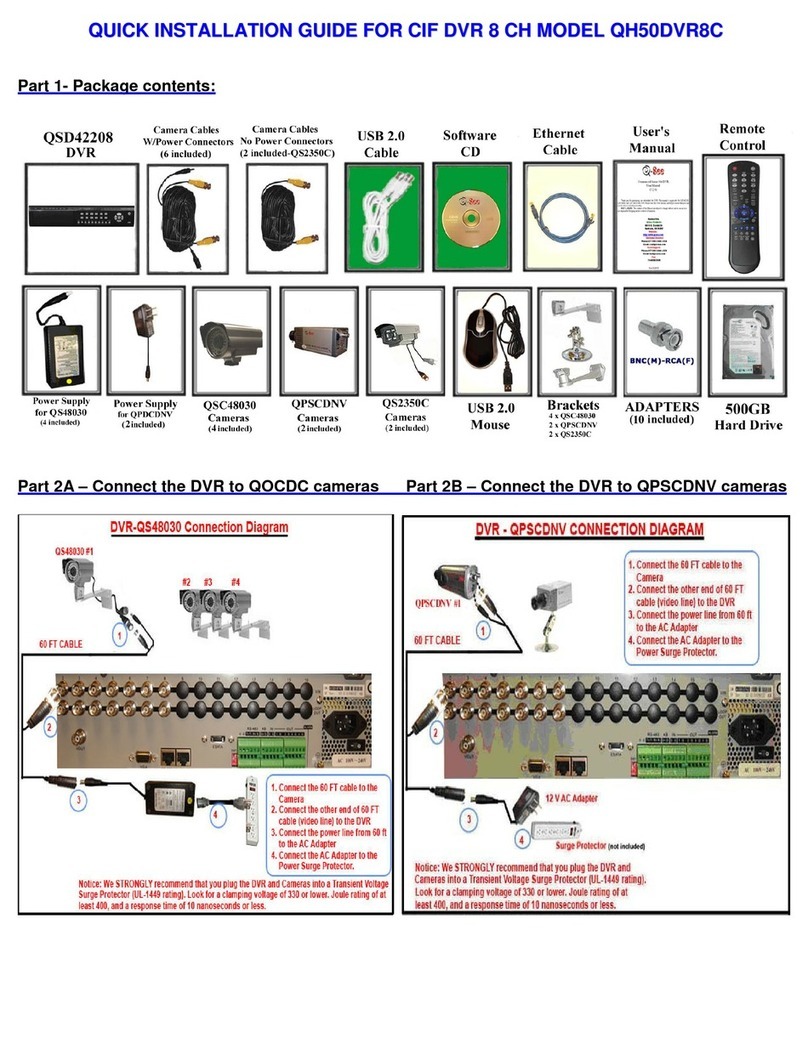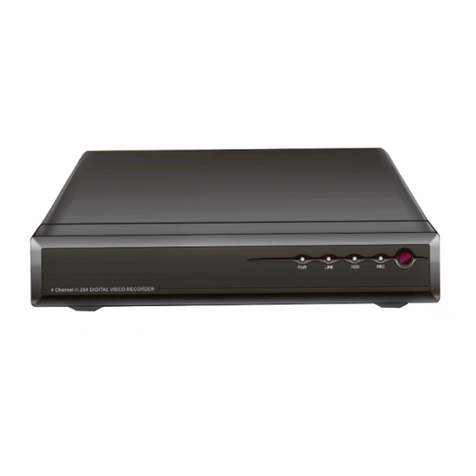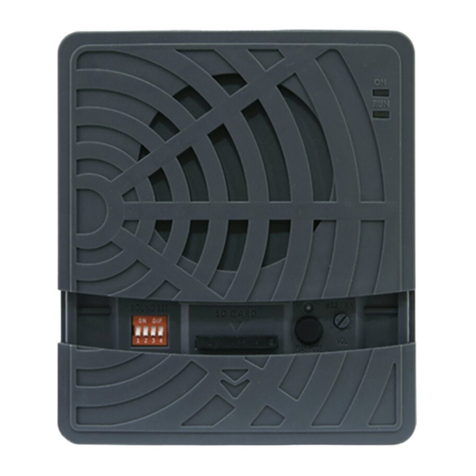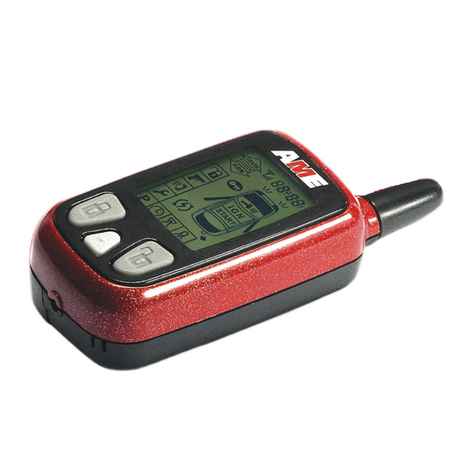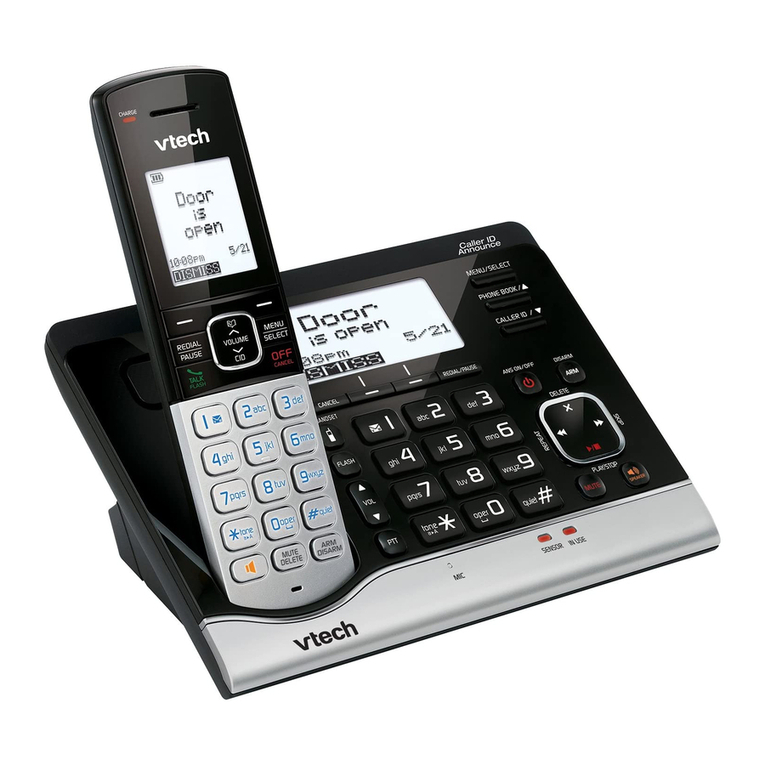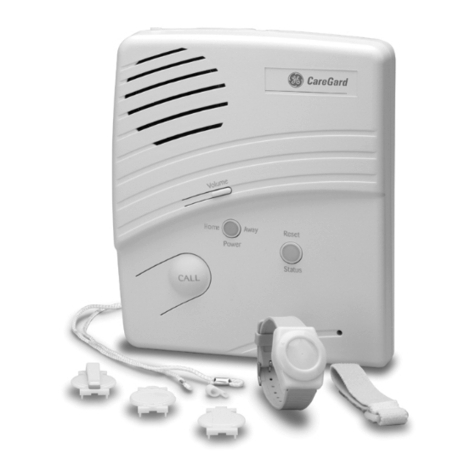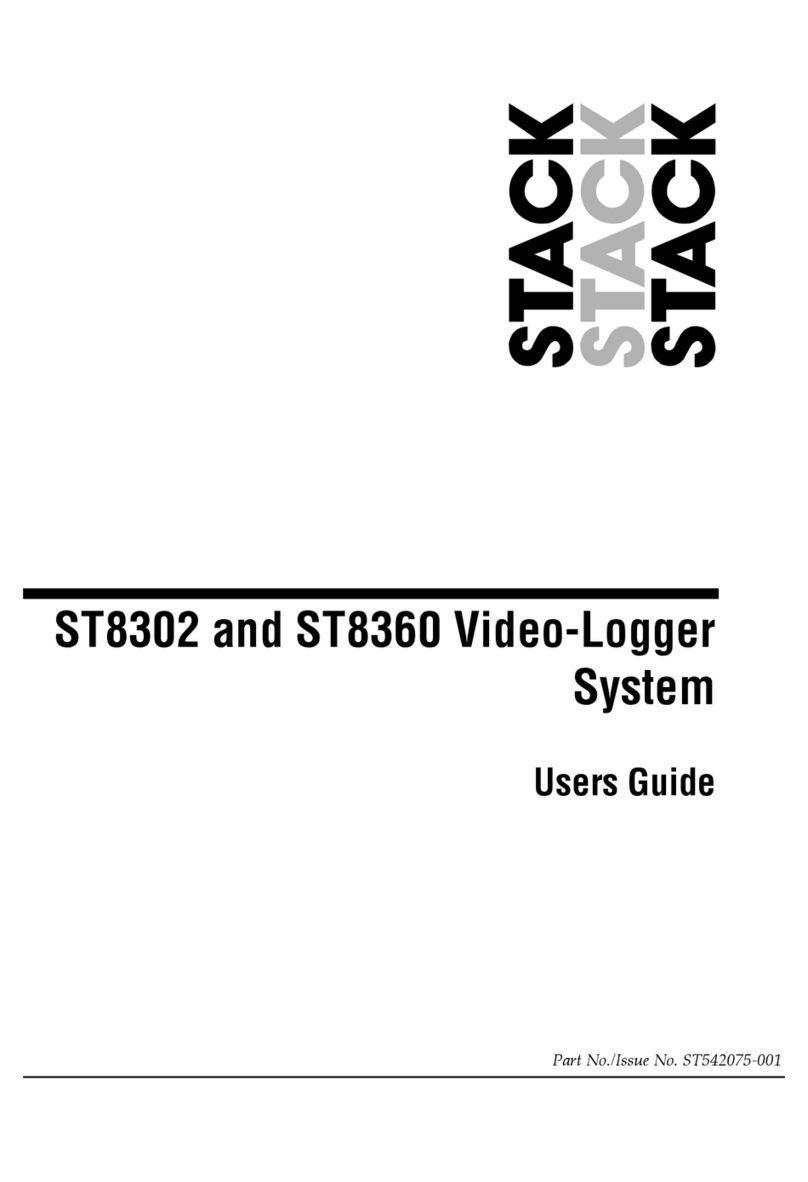Electronic Devices Limited ED816A User manual

ELECTRONIC
DEVICES
LIMITED TYPE ED 816A
ADDRESSABLE ALARM SYSTEM
E
D
ENIGMA HOUSE, ENIGMA BUSINESS PARK, MALVERN, WORCESTERSHIRE WR14 1GD ENGLAND.
TELEPHONE : +44 (0) 1684 891500 FACSIMILE: +44 (0) 1684 891600 EMAIL: sales@electronicdevice.demon.co.uk
ED816A SYSTEM
INSTRUCTION MANUAL
ED816A Addressable Fire and gas detection Installation manual 8-9-08 Rev-a
AC MAIN AUX
1 2 3
17 18
DC
POWER IN
DC CHR FLT
BATT
POWER OUT
PRE DEL FLT
FIRE / GAS ALARM
MUTE ISOL DEL TEST
PANEL / DEVICE STATUS
EVAC
4 5 6 7 8 9 10 11 12 13 14 15 16
19 20 21 22 23 24 25 26 27 28 29 30 31 32
+
_
ENT MENU EVAC MUTE RESET LAMP
TEST
FIRE / GAS DETECTOR TYPE ED816A
E
D
COMMSALM
MANUFACTURED BY ELECTRONIC DEVICES LTD., MALVERN, ENGLAND.
ZONES 1 - 32
ALM
POWER - IN LAMPS
POWER - OUT LAMPS
FIRE / GAS LAMPS
-
PANEL / DEVICE STATUS LAMPS
AC - AC SUPPLYINPUT HEALTHY
DC MAIN - MAIN DC INPUT HEALTHY
DC AUX - OPTIONALAUXILIARY DC INPUT
HEALTHY
DC - DC OUTPUT SUPPLY HEALTHY
BATT CHR - BATTERY CHARGING
BATT FLT- BATTERY FAULT / BATTERY
REQUIRES EXTERNAL CHARGING
PRE - PRE-ALARM LEVEL
DEL - DELAYEDALARM OPERATED
FLT - PANEL / LOOP / DEVICE FAULT
EVAC - EVACUATE
MUTE - SOUNDERS HAVE BEEN SILENCED
ISOL - ISOLATED, ONE OR MORE ZONES
HAVE BEEN INHIBITED
DEL - ONE OR MORE DEVICE OUTPUTS
HAVE BEEN DELAYED
TEST - WHILST IN TEST MODE THE
ZONE UNDER TEST WILL NOT INITIATE
ALARMS. REMAINING ZONES WILL
CONTINUE TO FUNCTION NORMALLY
COMMS - COMMUNICATION FAULT
FIRE ALARM, GAS ALARM
- USE TO SCROLL THROUGH CURRENT
EVENTS AND NAVIGATE MENU
- USE TO NAVIGATE MENU
- INCREMENT / DECREMENT
ENT - ENTER / CONFIRM
MENU - MAIN MENU / PREVIOUS MENU
EVAC - EVACUATE OPERATES ALLOUTPUT
DEVICES
MUTE - SILENCE SOUNDERS
RESET - RESET SYSTEM TO NORMAL
CONDITION FOLLOWING ALARM / FAULT
LAMP TEST - PRESSTO TESTALL LAMPS
KEYS
+/-
14:29 27/11/06 ED816 ALARM SYSTEM
NO OF DETECTORS IN ALARM: 1 IN 1 ZONES
DETECTOR 1/ 1:
14:27
ISOL ZONES 0
27/11/06 ENGINE ROOM
HEAT DETECTOR LOOP 2 ID 035 ZONE 2
PRE ALARMS 0 FAULTS 0

-2-
3
4
INDEX
INTRODUCTION
DESIGN, INSTALLATION & SETUP
SECTION 1
Component overview
ED722 and ED726 Loop Driver Module 4
7
Loop lengths 7
Loop loading 7
Loop cable selection 7
Loop cable resistance 7
Loop cable capacitance 8
Screen continuity 8
Repeater cable selection 8
Power supply 8
9
General 9
ED816A I/O Module PCB connections 10
Detector Base wiring diagrams 11
Sounder wiring diagram 11
Repeater wiring diagram 12
13
PC based setup software (FireConfig.exe) 13
14
Important note 14
Maximum number of entries 14
Adding cause and effect entries 15
Auxiliary relay 16
Sounders 16
Loop device - Sounders and beacons 16
Loop device - Input Output modules 17
Delayed Outputs 17
18
XP95(A) North American models 18
Input Output modules / units 18
Loop powered Sounders and Beacons 18
Discovery Detectors 18
Gas Detection 19
Group Addressed Sounders / Beacons 19
Master / Slave Sounders / Beacons 19
ED816A Display Module 5
ED816A Input / Output Module 6
SECTION 2
System design guidelines
SECTION 3
Control unit installation
SECTION 4
Initial system setup
SECTION 5
Cause and effect matrix
SECTION 6
Device types and configuration
20
Silencing sounders and beacons 20
System reset 20
Evacuate 20
21
Gas Detection 24
Delayed Alarms 25
Reboot system 25
Live values - System Voltages 25
Live values - Head Values 26
View faults 28
View pre-alarms 28
View isolates 28
29
IO to loop cable fault 29
Loop continuity fault 29
No response from sensor 29
Sensor internal fault 29
Short circuit / Open circuit fault 29
Supply voltage fault 29
Communications fault 29
Discovery Conventional Mode /
Hardware Fire Detection 30
OPERATING INSTRUCTIONS
SECTION 7
Operating Instructions - quick guide
SECTION 9
Fault messages
SECTION 10
Dual Redundancy
21
Main Menu 22
History 22
Isolate / De-isolate 22
System setup 23
System setup - Walk through test 23
System setup - Sounder Beacon test 23
System setup - Search for new devices 24
System setup - Set time and date 24
System Menu 24
SECTION 8
Operating instructions 21
Access levels
Switch on / Reboot screen
ED816A Addressable Fire and gas detection Installation manual 8-9-08 Rev-a

Smoke
Call point
Beacon base
Output module
Damper shutdown
HVAC shutdown
Gas sensor Gas sensor Gas sensor
EOL
Conventional Zone 1
Conventional Zone 2
EOL
Level Detection
Isolating base
Heat
SmokeSmoke
Call point Multi sensor
Integrated
base sounder
Isolating base
CO Fire
detector
EOL
ZONE MONITOR
Conventional Zone
Smoke
Gas detector
interface Gas detector
interface
Gas detector
interface
Isolating base
Switch monitor
Door switches
Heat
Smoke Heat
Remote
indicator
Isolating base
Smoke
Smoke
Isolating base
Zone monitor
EOL
Conventional Zone
LOOP 1
AC MAIN AUX
1 2 3
17 18
DC
POWER IN
DC CHR FLT
BATT
POWER OUT
PRE DEL FLT
FIRE / GASALARM
MUTE ISOL DEL TEST
PANEL/ DEVICE STATUS
EVAC
4 5 6 7 8 9 10 11 12 13 14 15 16
19 20 21 22 23 24 25 26 27 28 29 30 31 32
+
_
ENT MENU EVAC MUTE RESET LAMP
TEST
FIRE / GAS DETECTOR REPEATER
E
D
COMMSALM
MANUFACTURED BY ELECTRONIC DEVICES LTD.,MALVERN, ENGLAND.
ZONES 1 - 32
ALM
POWER- IN LAMPS
POWER- OUT LAMPS
FIRE/ GAS LAMPS
-
PANEL/ DEVICE STATUSLAMPS
AC- AC SUPPLY INPUT HEALTHY
DCMAIN - MAIN DC INPUT HEALTHY
DCAUX - OPTIONAL AUXILIARYDC INPUT
HEALTHY
DC- DC OUTPUT SUPPLY HEALTHY
BATTCHR - BATTERYCHARGING
BATTFLT- BATTERYFAULT/ BATTERY
REQUIRESEXTERNAL CHARGING
PRE- PRE-ALARM LEVEL
DEL- DELAYED ALARM OPERATED
FLT- PANEL/ LOOP / DEVICE FAULT
EVAC- EVACUATE
MUTE- SOUNDERS HAVE BEEN SILENCED
ISOL- ISOLATED, ONE OR MORE ZONES
HAVE BEEN INHIBITED
DEL- ONE OR MORE DEVICE OUTPUTS
HAVEBEEN DELAYED
TEST- WHILST IN TEST MODE THE
ZONEUNDER TEST WILL NOT INITIATE
ALARMS. REMAINING ZONES WILL
CONTINUETO FUNCTION NORMALLY
COMMS- COMMUNICATION FAULT
FIREALARM, GAS ALARM
-USE TO SCROLL THROUGH CURRENT
EVENTSAND NAVIGATEMENU
-USE TO NAVIGATEMENU
-INCREMENT / DECREMENT
ENT- ENTER / CONFIRM
MENU- MAIN MENU / PREVIOUS MENU
EVAC- EVACUATEOPERATES ALL OUTPUT
DEVICES
MUTE- SILENCE SOUNDERS
RESET- RESET SYSTEM TO NORMAL
CONDITIONFOLLOWING ALARM / FAULT
LAMPTEST - PRESS TOTEST ALL LAMPS
KEYS
+/-
14:29 27/11/06 ED816 ALARM SYSTEM
NO OF DETECTORS IN ALARM: 1 IN 1 ZONES
DETECTOR 1/ 1:
14:27
ISOL ZONES 0
27/11/06 ENGINE ROOM
HEAT DETECTOR LOOP 2 ID 035 ZONE 2
PRE ALARMS 0 FAULTS 0
EOL
Fault monitored Flameproof Beacons and Sounders
Conventional Zones 1and 2
can be Safe Area, Hazardous Area,
Fire or level detection.
AC MAIN AUX
1 2 3
17 18
DC
POWER IN
DC CHR FLT
BATT
POWER OUT
PRE DEL FLT
FIRE / GASALARM
MUTE ISOL DEL TEST
PANEL/ DEVICE STATUS
EVAC
4 5 6 7 8 9 10 11 12 13 14 15 16
19 20 21 22 23 24 25 26 27 28 29 30 31 32
+
_
ENT MENU EVAC MUTE RESET LAMP
TEST
FIRE / GAS DETECTOR REPEATER
E
D
COMMSALM
MANUFACTURED BY ELECTRONIC DEVICES LTD.,MALVERN, ENGLAND.
ZONES 1 - 32
ALM
POWER- IN LAMPS
POWER- OUT LAMPS
FIRE/ GAS LAMPS
-
PANEL/ DEVICE STATUSLAMPS
AC- AC SUPPLY INPUT HEALTHY
DCMAIN - MAIN DC INPUT HEALTHY
DCAUX - OPTIONAL AUXILIARYDC INPUT
HEALTHY
DC- DC OUTPUT SUPPLY HEALTHY
BATTCHR - BATTERYCHARGING
BATTFLT- BATTERYFAULT/ BATTERY
REQUIRESEXTERNAL CHARGING
PRE- PRE-ALARM LEVEL
DEL- DELAYED ALARM OPERATED
FLT- PANEL/ LOOP / DEVICE FAULT
EVAC- EVACUATE
MUTE- SOUNDERS HAVE BEEN SILENCED
ISOL- ISOLATED, ONE OR MORE ZONES
HAVE BEEN INHIBITED
DEL- ONE OR MORE DEVICE OUTPUTS
HAVEBEEN DELAYED
TEST- WHILST IN TEST MODE THE
ZONEUNDER TEST WILL NOT INITIATE
ALARMS. REMAINING ZONES WILL
CONTINUETO FUNCTION NORMALLY
COMMS- COMMUNICATION FAULT
FIREALARM, GAS ALARM
-USE TO SCROLL THROUGH CURRENT
EVENTSAND NAVIGATEMENU
-USE TO NAVIGATEMENU
-INCREMENT / DECREMENT
ENT- ENTER / CONFIRM
MENU- MAIN MENU / PREVIOUS MENU
EVAC- EVACUATEOPERATES ALL OUTPUT
DEVICES
MUTE- SILENCE SOUNDERS
RESET- RESET SYSTEM TO NORMAL
CONDITIONFOLLOWING ALARM / FAULT
LAMPTEST - PRESS TOTEST ALL LAMPS
KEYS
+/-
14:29 27/11/06 ED816 ALARM SYSTEM
NO OF DETECTORS IN ALARM: 1 IN 1 ZONES
DETECTOR 1/ 1:
14:27
ISOL ZONES 0
27/11/06 ENGINE ROOM
HEAT DETECTOR LOOP 2 ID 035 ZONE 2
PRE ALARMS 0 FAULTS 0
Up to 8 repeaters
Sounder circuit 1
Sounder circuit 2
Sounder circuit 3
Engineers PC
Alarm relay contacts
Pre - Alarm relay contacts
Delayed Alarm relay contacts
Fault relay contacts
Auxiliary relay contacts
Auxiliary relay contacts
Auxiliary relay contacts
HWFD relay contacts to
additional Fire alarm Panels
INTRODUCTION
The ED816A Analogue Addressable Alarm system is capable of giving
Fire, Gas, Water and/or Engine alarms, operate Fire Fighting
equipment and is approved to Lloyds Register ENV1, 2, and 3.
It is capable of driving up to 252 addressable devices per system in 2
loops of 126 devices per loop.
The ED816A has an enclosure 365 x 340 x 110mm weighing 7.5Kg.
Contact Electronic devices limited on:
Tel: +44 (0)1684 891500
Fax: +44 (0)1684 891600
Email: [email protected]
LOOP 2
-3-
AC MAIN AUX
1 2 3
17 18
DC
POWER IN
DC CHR FLT
BATT
POWER OUT
PRE DEL FLT
FIRE / GAS ALARM
MUTE ISOL DEL TEST
PANEL/ DEVICE STATUS
EVAC
4 5 6 7 8 9 10 11 12 13 14 15 16
19 20 21 22 23 24 25 26 27 28 29 30 31 32
+
_
ENT MENU EVAC MUTE RESET LAMP
TEST
FIRE / GAS DETECTOR TYPE ED816A
E
D
COMMS
ALM
MANUFACTURED BY ELECTRONIC DEVICES LTD.,MALVERN, ENGLAND.
ZONES 1 - 32
ALM
POWER- IN LAMPS
POWER- OUT LAMPS
FIRE/ GAS LAMPS
-
PANEL/ DEVICE STATUSLAMPS
AC- AC SUPPLY INPUT HEALTHY
DCMAIN - MAIN DC INPUT HEALTHY
DCAUX - OPTIONAL AUXILIARY DC INPUT
HEALTHY
DC- DC OUTPUT SUPPLY HEALTHY
BATTCHR - BATTERY CHARGING
BATTFLT - BATTERYFAULT / BATTERY
REQUIRESEXTERNAL CHARGING
PRE- PRE-ALARM LEVEL
DEL- DELAYED ALARM OPERATED
FLT- PANEL / LOOP / DEVICE FAULT
EVAC- EVACUATE
MUTE- SOUNDERS HAVE BEEN SILENCED
ISOL- ISOLATED, ONE OR MORE ZONES
HAVE BEEN INHIBITED
DEL- ONE OR MORE DEVICE OUTPUTS
HAVEBEEN DELAYED
TEST- WHILST IN TEST MODE THE
ZONEUNDER TEST WILL NOT INITIATE
ALARMS. REMAINING ZONES WILL
CONTINUETO FUNCTION NORMALLY
COMMS- COMMUNICATION FAULT
FIREALARM, GAS ALARM
-USE TO SCROLL THROUGH CURRENT
EVENTSAND NAVIGATE MENU
-USE TO NAVIGATE MENU
-INCREMENT / DECREMENT
ENT- ENTER / CONFIRM
MENU- MAIN MENU / PREVIOUS MENU
EVAC- EVACUATE OPERATESALL OUTPUT
DEVICES
MUTE- SILENCE SOUNDERS
RESET- RESET SYSTEM TO NORMAL
CONDITIONFOLLOWING ALARM / FAULT
LAMPTEST - PRESSTO TEST ALL LAMPS
KEYS
+/-
14:29 27/11/06 ED816 ALARM SYSTEM
NO OF DETECTORS IN ALARM: 1 IN 1 ZONES
DETECTOR 1/ 1:
14:27
ISOL ZONES 0
27/11/06 ENGINE ROOM
HEAT DETECTOR LOOP 2 ID 035 ZONE 2
PRE ALARMS 0 FAULTS 0
ED816A Addressable Fire and gas detection Installation manual 8-9-08 Rev-a

The ED722 and ED726 loop driver can provide 300mA of continuous loop current, driving up to
126 devices using Apollo S90, XP95 or Discovery protocol.
Each loop is fully isolated electrically from the input power supply, giving continued operation
in the event of earth faults on the dc input, greatly increasing immunity to electrical noise and
eliminating false alarms due to crosstalk.
The ED722 and ED726 are similar but the ED726 can also accept up to 10 EDL addressable
gas detection interface modules. Both models are available with front panels, as used in the
ED700A 8 Loop Control Panel, or without front panels for use in the ED816A. For the full
failsafe features to be available on the ED816A the ED722 / ED726 front panel lamps and
switches are relocated on the ED816A I/O motherboard.
FAIL SAFE OPERATION
Each module within the system (ED722/6 loop modules, ED816A Display module and ED816
I/O module) communicate with each other using an industry standard I2C bus. In the event of
a communications failure, or a fault developing on any of the modules, creating a
communications failure, the loop cards continue to operate autonomously.
The loop modules are directly connected to the following normally energised relays mounted
on the IO module.
HWFD = normally open contact closing to 470 ohms in the alarm condition.
PRE = Pre-alarm.
IMM = Immediate Fire or Gas Alarm.
DEL = Operates 2 minutes after an alarm if mute or reset has not been pressed.
FLT = Fault.
Sounder 1 is directly connected to the alarm relay.
DISCOVERY CONVENTIONAL MODE (Hardware Fire Detection HWFD)
Not to be confused with conventional fire zones, conventional mode, built into the Discovery
detectors and Electronic Devices gas detector interface, provides continued alarm detection in
the event of limited circuit failure. E.g. Microprocessor failure on the loop module resulting in
panel to detector communications failure. Conventional mode becomes operational
approximately 2 minutes after loop to detector communications has failed. Electronic Devices
recommend using Discovery detectors to take advantage of this feature.
PUSH BUTTON OPERATION
If pressed under normal operating conditions the three push buttons operate as lamp test
buttons only. However in the event of a communications error or fault on the Addressable
display module, the loop cards continue to operate autonomously and the push buttons will
function as labelled. See page 29 for details.
These should be used for all safety critical operations as they are operated
in the fail safe mode.
Section 1 - Component overview.
ED722 and ED726 Loop Driver Module (ED816A Variation)
-4-
ED816A Addressable Fire and gas detection Installation manual 8-9-08 Rev-a
Back up alarm / indicator lamps
EVACUATE MUTE RESET
POWER
ALARM
PRE-ALM
DELAYED
FAULT
SILENCED
ISOLATED
LOOP 1 STATUS
EVACUATE MUTE RESET
POWER
ALARM
PRE-ALM
DELAYED
FAULT
SILENCED
ISOLATED
LOOP 2 STATUS
Lamp Test button and backup Reset
button.
(See below for usage)
Lamp Test button and backup Evacuate
Lamp Test button and backup Mute
button.

The ED816A Display module provides all system information during normal operation. Detailed information
about each device connected to the system, system voltages, Isolated zones, delay times and function are all
available.
Also available is a Marine approved Repeater unit, with identical functionality, connected to the main panel via
RS485 full duplex. Up to 8 repeaters can be connected to the main system.
LED FUNCTION (left to right)
AC AC mains connected.
MAIN Main DC input connected.
AUX Aux DC input connected.
DC Fused DC output okay.
CHR Battery being charged.
FLT Battery fault.
FIRE Main Fire or Gas Alarm.
PRE Pre alarm early warning of Fire or Gas Alarm.
DEL Delayed Alarm, Fire or Gas Alarm has been present for 2 minutes without being acknowledged.
FLT Fault on System, wiring or loop device.
EVAC Evacuate condition has been implemented.
MUTE Sounders / Beacons have been silenced.
ISOL 1 or more zones have been isolated.
DEL Delayed output, one of the 8 delayed outputs will action after preset time.
TEST System is currently in test mode.
COMMS Communications failure has occurred.
1 - 32 Zone LEDs, indicating a Fire / Gas alarm.
PUSH BUTTON FUNCTION(left to right)
Use to scroll through current events and navigate menu.
Use to navigate menu.
+/- Increment / decrement.
ENT Enter confirm.
MENU Previous menu / main menu.
EVAC Evacuate, operates all output devices.
MUTE Turn off Sounders and Beacons.
RESET Reset to normal condition following alarm or fault.
LAMP TEST Test all Display Module lamps. -5-
ED816A Display Module
AC MAIN AUX
1 2 3
17 18
DC
POWER IN
DC CHR FLT
BATT
POWER OUT
PRE DEL FLT
FIRE / GAS ALARM
MUTE ISOL DEL TEST
PANEL / DEVICE STATUS
EVAC
4 5 6 7 8 9 10 11 12 13 14 15 16
19 20 21 22 23 24 25 26 27 28 29 30 31 32
+
_
ENT MENU EVAC MUTE RESET LAMP
TEST
FIRE / GAS DETECTOR TYPE ED816A
E
D
COMMS
ALM
MANUFACTURED BY ELECTRONIC DEVICES LTD., MALVERN, ENGLAND.
ZONES 1 - 32
ALM
POWER - IN LAMPS
POWER - OUT LAMPS
FIRE / GAS LAMPS
-
PANEL / DEVICE STATUS LAMPS
AC - AC SUPPLY INPUT HEALTHY
DC MAIN - MAIN DC INPUT HEALTHY
DC AUX - OPTIONAL AUXILIARY DC INPUT
HEALTHY
DC - DC OUTPUT SUPPLY HEALTHY
BATT CHR - BATTERY CHARGING
BATT FLT - BATTERY FAULT / BATTERY
REQUIRES EXTERNAL CHARGING
PRE - PRE-ALARM LEVEL
DEL - DELAYED ALARM OPERATED
FLT - PANEL / LOOP / DEVICE FAULT
EVAC - EVACUATE
MUTE - SOUNDERS HAVE BEEN SILENCED
ISOL - ISOLATED, ONE OR MORE ZONES
HAVE BEEN INHIBITED
DEL - ONE OR MORE DEVICE OUTPUTS
HAVE BEEN DELAYED
TEST - WHILST IN TEST MODE THE
ZONE UNDER TEST WILL NOT INITIATE
ALARMS. REMAINING ZONES WILL
CONTINUE TO FUNCTION NORMALLY
COMMS - COMMUNICATION FAULT
FIRE ALARM, GAS ALARM
- USE TO SCROLL THROUGH CURRENT
EVENTS AND NAVIGATE MENU
- USE TO NAVIGATE MENU
- INCREMENT / DECREMENT
ENT - ENTER / CONFIRM
MENU - MAIN MENU / PREVIOUS MENU
EVAC - EVACUATE OPERATES ALL OUTPUT
DEVICES
MUTE - SILENCE SOUNDERS
RESET - RESET SYSTEM TO NORMAL
CONDITION FOLLOWING ALARM / FAULT
LAMP TEST - PRESS TO TEST ALL LAMPS
KEYS
+/-
14:29 27/11/06 ED700 ALARM SYSTEM
NO OF DETECTORS IN ALARM: 1 IN 1 ZONES
DETECTOR 1/ 1:
14:27
ISOL ZONES 0
27/11/06 ENGINE ROOM
HEAT DETECTOR LOOP 2 ID 035 ZONE 2
PRE ALARMS 0 FAULTS 0
ED816A Addressable Fire and gas detection Installation manual 8-9-08 Rev-a

ED816A Input / Output Module
-6-
The Input / Output module provides all of the facilities required for most applications, eliminating the need to
purchase additional add-on modules or interface units.
Designed with ease of installation in mind the I/O Module is fitted with large terminals capable of easily
accepting 4mm square conductors.
The I/O module provides the following:
Loop input / output terminals for up to 2 loops.
2 x Conventional Fire Detection Zones, ideal for utilising existing conventional detectors when retro fitting.
Suitable detectors are Apollo S60 / S65, Apollo Orbis, Tyco M600 and the Hochiki CDX range.
1 x RS232 Comms port for connection to a PC or a laptop running Electronic Devices FireConfig.exe Windows
software Application. Use a straight through (not null modem) serial cable with a 9 pin D type male
connector on one end and female on the other. If using a laptop which does not have a suitable serial port
you will also need a USB to Serial port converter.
1 x RS485 Full Duplex Comms port for connection to up to 8 Repeater modules.
1 x HWFD Relay Output, (Hardware Fire Detection). Normally energised relay output for connection to
additional control panels or third party conventional / addressable fire panel. The HWFD contacts are
normally open and close to 470 Ohms in the event of an alarm condition. Importantly this relay will
continue to operate correctly in the event of internal panel communications failure and also loop
communications failure (discovery detectors and EDL gas detectors only).
All relays are Voltage free change over contacts. All are rated at 2.5A @ 30V d.c. non inductive.
1 x Fire Alarm Relay, fail safe hardware driven.
1 x Delayed Fire Alarm Relay.
1 x Pre Alarm Relay.
1 x Fault Alarm Relay contacts.
3 x Auxiliary Alarm Relay contacts, 3 Relays each with 2 sets of
Contacts. Configurable using PC application.
3 x Monitored Sounder Circuits rated 1A ; 24V dc. Sounder circuit 1 is fail safe, hardware driven.
Sounder circuits 2 and 3 are software driven and configurable.
2 x 24V DC Monitored Fused Outputs.
1 x Auxiliary DC Monitored Input, 24V dc +/- 25%..
1 x Battery Input with automatic charging and disconnection before battery damage can occur.
1 x Main DC Monitored Input, normally used with the internal Power Supply, 24V dc +/- 25%..
1 x Main AC Monitored Input.
1 x Internal Buzzer (comms failure).
MAINS
AC
MAIN
DC
AUX
DC
PC
SETUP
1 - 8 FIRE / GAS
LOOPS
2
CONVENTIONAL
ZONES
3 AUX
RELAY
VFC
3 SOUNDER CCTS
REPEATERS
HARDWARE FIRE / GAS
DETECTION (HWFD)
TO ADDITIONAL
FIRE / GAS PANELS
DC
OUT
PRE
ALARM
VFC
ALARM
VFC
DELAY
ALARM
VFC
FAULT
VFC
I/O MODULE
ED816A Addressable Fire and gas detection Installation manual 8-9-08 Rev-a

-7-
Section 2 - System design guidelines
LOOP LENGTHS
LOOP LOADING - Maximum number of addresses
LOOP LOADING - Short circuit isolators
LOOP CABLE SELECTION
LOOP CABLE RESISTANCE
The maximum permitted loop length can be determined using Apollo’s loop calculator, available free from EDL.
Remember to include the vertical distances when looking at plan drawings and also ensure cable capacitance is
within the panels specification.
The maximum number of addresses is 126 per loop. System designers should avoid fully loading loops. The
optimum number of addresses per loop is approximately 90 to 100, this ensures the system is operating well
within its capacity and allows the customer flexibility in the future to add additional devices.
Short circuit isolators should be fitted with no more than 20 detectors between isolators. No more than 10
detectors (or equivalent load) between the panel and the first isolator and no more than 10 detectors (or
equivalent load) between the panel and last isolator. Ideally the first and last items fitted to a loop should be
isolators.
Isolators should always be fitted at zone boundaries and it is good practice to reduce the number of times loop
wiring enters and leaves the same zone. A single fault on a loop should not remove protection from an area
greater than a single zone.
Two simultaneous faults on a loop should not remove protection from an area greater than 10,000 sq m . This
requirement limits the total floor area covered by one loop to 10,000 sq m regardless of the number of
detectors.
Isolators are available as standalone or built in to detector bases and integrated in to Apollo interface modules .
The additional cost of the built in isolators is small compared to the non isolated bases or interface units
therefore as many isolators should be fitted as possible.
Short circuit isolators do not use up addresses and there is no limit to the number of isolators fitted.
Each loop card is fitted with two onboard short circuit isolators, one for loop out and one for loop return,
protecting the wiring between the panel and first and last isolator.
The cable must be a suitable type e.g. FireTuf, FP200 or equivalent and must have the following characteristics:
1. The cable must be 2 core with screen + drain core.
2. Loop out and loop in should never be run within the same cable.
3. Multicore cable should never be used.
The maximum permissible resistance per core is 12.8 Ohms at maximum load (300mA). Loops with lower
loads can accept higher cable resistance, however it is good practice to consider the maximum load at the
design stage thus allowing for future expansion.
Core diameter Typical resistance (FP200 / FireTuf)
1.0mm 18.1 Ohms/Km/Core
1.5mm 12.1 Ohms/Km/Core
2.5mm 7.4 Ohms/Km/Core
4.0mm 4.6 Ohms/Km/Core
ED816A Addressable Fire and gas detection Installation manual 8-9-08 Rev-a

System design guidelines - continued
LOOP CABLE CAPACITANCE
SCREEN CONTINUITY
REPEATER CABLE SELECTION
POWER SUPPLY
Cable capacitance is an important consideration when choosing loop cable.
The maximum permissible capacitance is 0.5uF (500nF) between loop + and loop -.
As each loop is electrically isolated therefore high loop to screen capacitance does not normally cause a
problem and should not be the limiting factor for loop lengths.
Typical capacitance per 100m (FP200 / FireTuf)
Core diameter core to core core to screen
1.0mm 10nF 17.5nF
1.5mm 12nF 20.5nF
2.5mm 13nF 24.0nF
It is vital, for correct and trouble free operation, that the screen is continuous along the full loop length. Ensure
that the screen connection is continued at each loop device. The screen should be earthed at one end only, via
the control panel, and never at loop devices.
All cables entering the control unit should be screened and ferrite sleeves, supplied with the control unit, must
be used. All screens should be terminated at the control panel only thereby avoiding earth loops.
See page 9 for connection diagram.
Note the repeater data cable screens must NOT be connected to the enclosure (earth) and instead connected
to the terminals marked SCRN inside the control unit and repeater units.
The repeater communicates with the control panel using the industry standard RS485 full duplex.
The data cable used should be 2 conductor (twisted) 124 Ohm twinixial 25 AWG (0.16 sq mm) with foil screen
and drain wire. E.g. Beldon 9271 006 (BLULT).
Repeaters can be powered locally to avoid running additional power cables or they can be powered from the
control unit using the fused output terminals. Up to 8 repeaters can be connected to each system, however if
powered from the control panel the repeater current consumption should be included in power supply and
battery calculations.
Each repeater can operate from 18 - 30Vdc with a worst case current consumption of 350mA.
See page 10 for connection diagram.
The control unit requires a nominal 24V dc supply and must always have batteries connected. Normally the AC
mains is connected to the AC mains input terminals and the AC mains output terminals are wired to the external
power supply. The power supplies DC output is connected to the systems main DC input terminals.
Auxiliary DC input terminals are provided as an additional option. The DC input and Auxiliary (if used) must be
suitably rated to charge the internal batteries.
All power supply cables must be screened and ferrite rings used and cables should not be routed near EMC
generating equipment, radio transmitters, paging systems etc., See page 9.
-8-
ED816A Addressable Fire and gas detection Installation manual 8-9-08 Rev-a

Section 3 - Control unit installation
GENERAL
WARNING: Please read this section completely before commencing installation.
The panel must be located in a clean, dry position at least 2 metres away from any radio transmitting equipment
e.g Pager systems.
NOTE
When changing any plug-in cards or loop devices, observe anti-static precautions. Ensure that all power is
removed and the system is switched off. Failure to do so may result in damage to the cards or panel.
The panel be switched off before removing or replacing any card or module. Failure to observe this may
cause damage to the printed circuit boards.
Each loop card has an ID, set via the dip switches mounted on each loop card. No two loop card should have
the same ID.
FireConfig.exe must be used for initial system setup.
The Mains supply should be installed in accordance with the current edition of the IEE wiring regulations.
Connection to the mains supply must be via an isolating protective device (e.g. an isolating fuse) reserved
solely for the fire alarm system. It should be insured that all isolating switches, circuit breakers etc., connected
to the system should be labelled “FIRE ALARM DO NOT SWITCH OFF”.
Correct earthing is vital for trouble free operation. The earth connection should be as short as possible, using
4mm square conductors, connected directly to a good quality earth. The earth should not be routed via radio
transmitting devices or other electrical equipment.
All cables entering the control unit should be screened and ferrite sleeves, supplied with the control unit, should
be used. All screens should be terminated at the cable gland. Only metal, EMC shielding cable glands should
be used. Screens should be continuous and have continuity along the entire length of the cable. Only connect
the screen to earth at one end thus avoiding earth loops. All unscreened conductors should be kept as short as
possible and the ferrite ring should be as close to the cable gland as possible. Wrap each conductor around the
ferrite at least twice. Any communication faults experienced are likely to be caused by poor EMC shielding
practices. Repeater cable screens should never be connected to earth, always use the terminals provided.
MUST
LOOP OUT LOOP IN
SCREEN CONNECTED
TO METAL CABLE GLAND
ENSURE GOOD
CONNECTION BETWEEN
GLAND AND ENCLOSURE
SHORT CIRCUIT ISOLATORS ARE
ALWAYS THE FIRST AND LAST
DEVICE ON A LOOP AND SHOULD
ALWAYS BE USED AT ZONE
BOUNDARIES.
ISOLATOR ISOLATOR
ISOLATOR
CONDUCTORS WRAPPED
AROUND FERRITE CORE
ISOLATOR
ZONE 1 ZONE 32
ZONE 2 SCREEN NOT EARTHED
AT THIS END
-9-
ED816A Addressable Fire and gas detection Installation manual 8-9-08 Rev-a

ED816A I/O BOARD CONNECTIONS
EVACUATE MUTE RESET
POWER
ALARM
PRE-ALM
DELAYED
FAULT
SILENCED
ISOLATED
LOOP 1 STATUS
EVACUATE MUTE RESET
POWER
ALARM
PRE-ALM
DELAYED
FAULT
SILENCED
ISOLATED
LOOP 2 STATUS
SCRN
B
A
SCRN
Y
Z
+ - + -
+ - + -
+ - + -
SCRN
Z1 Z2
CONVENTIONAL
IN OUT
LOOP 2
IN OUT
LOOP 1
LOOP 2
CONNECTIONS
PC CONNECTION
LOOP 2
CONNECTIONS
CONVENTIONAL
CONNECTIONS
REPEATER
CONNECTIONS
- +
+ - + - + -+ -+ -+ -
MAIN
24VDC
INPUT
AUX
24VDC
INPUT
24V
BATTERY
INPUT
FUSED 24VDC
OUTPUT
SOUNDER
OUTPUT
NO. 3
SOUNDER
OUTPUT
NO. 1
SOUNDER
OUTPUT
NO. 2
L N E
MAIN
AC
OUTPUT
L N E
MAIN
AC
INPUT
AUX # 5
RELAY CONTACTS
C NO NC
AUX # 3
C NO NC
AUX # 1
C NO NC
FAULT
C NO NC
DELAYED
ALARM
C NO NC
PRE-
ALARM
C NO NC
ALARM
C NO NC
HWFD
-10-
ED816A Addressable Fire and gas detection Installation manual 8-9-08 Rev-a

XP95 / DISCOVERY MOUNTING BASE WIRING DIAGRAM
-11-
L2
EARTH
L1
-R +R
SCREEN
LOOP -VE
LOOP +VE
SCREEN
LOOP -VE
LOOP +VE
4K7
EOL
APOLLO
ORBIS
LED -
COM -
OUT +
IN +
4
REMOTE
INDICATOR
APOLLO
ORBIS
LED -
COM -
OUT +
IN +
4
APOLLO
ORBIS
LED -
COM -
OUT +
IN +
4
REMOTE
INDICATOR
REMOTE
INDICATOR
1. Connect detector earth connection to cable screen
2. Always fit call points at the beginning of a zone or on a separate zone. Removal of detectors fitted between
the control unit and call points would disable the call points.
3. Never use looped wire for connection into and out from the same terminal, always break wire.
Any single wire coming loose from a terminal should open circuit the end of line resistor to enable a fault
to be indicated.
C O N V E N T I O N A L Z O N E S W I R I N G D I A G R A M
+VE
-VE
CONVENTIONAL
ZONE
XP95 / DISCOVERY ISOLATING BASE WIRING DIAGRAM
L2
EARTH
L1
-R +R
SCREEN
LOOP -VE
LOOP +VE
SCREEN
LOOP -VE
LOOP +VE
IN OUT
SCREEN
ED816A Addressable Fire and gas detection Installation manual 8-9-08 Rev-a

+
SOUNDER WIRING
The fault monitored sounder circuits can be used to operate several sounders and beacons up to a
maximum load of 1A. A 4K7 Ohm end of line resistor should be fitted across the last device to facilitate
fault monitoring. Note: SNDR1 is fail safe and should always be used first, with sounders / beacons in
a manned location.
-
+
-
-
-
SND 1
SND 2
+
-
+
-
-
-
SND 1
SND 2
+
-
+
-
4K7
EOL
+VE
-VE
SOUNDER CCT
1,2 OR 3
ED6 SOUNDER ED6 SOUNDER /
BEACON COMBINATION
ED6 BEACON
Never use looped wire always use separate conductors for input and outputs thus enabling fault
monitoring. If Sounders and Beacons are not supplied by EDL, ensure they have a series polarity
protection diode fitted. Please contact EDL for further information.
REPEATER WIRING
Up to eight repeaters can be connected to each system. The last repeater on the line must be a type A.
Type A and B repeaters differ only in that type A repeaters have terminating resistors, R2 and R39,
fitted.
Repeaters can be powered by a local, battery backed, 24Vdc supply or driven off the fused output
terminals provided in the ED816A. Each repeater draws a maximum of 350mA.
The data cable used should be 2 conductor (twisted) 124 Ohm twinixial 25 AWG (0.16 sq mm) with foil
screen and drain wire. E.g. Beldon 9271 006 (BLULT).
With full duplex wiring each repeater has exactly the same functionality as the main control panel, giving the
designer the option of using the repeater as the main interface. This allows the control panel to be situated in a
more central location.
It is possible to operate repeaters without their full functionality by omitting the repeater transmit wiring; i.e.
Wiring between Z, Y (repeater) and A, B (control panel).Thus the repeater can only receive information, no
information can be transmitted to the control panel including setup information etc.. Electronic Devices Limited
do not recommend this method because the EVAC button on the repeater will not function. However a solution
is to have a call point located next to the repeater set to “no zone”. Call points set to no zone automatically
operate the evacuate command when operated. It is for this reason all repeaters installed should be checked
they both transmit data as well as receive it from the control panel.
SCRN
B
A
SCRN
Z
Y
SCRN
Z
Y
SCRN
B
A
SCRN
Z
Y
SCRN
B
A
SCRN
Z
Y
SCRN
B
A
24V FUSED
OUTPUT
+
-
RS485 FULL DUPLEX
+
-
+
-
+
-
CONTROL PANEL
REPEATER
TYPE B
REPEATER
TYPE B
REPEATER
TYPE A
RX
TX
TX
RX
TX
RX
TX
RX
-12-
ED816A Addressable Fire and gas detection Installation manual 8-9-08 Rev-a

-13-
Section 4 - Initial system setup
FIRECONFIG
MUSTFireconfig.exe is a windows based application program which be used for initial system setup.
Install FireConfig.exe on to your Windows XP / Vista PC hard drive or run directly from a data stick if required.
Use a straight through (not null modem) serial cable with a 9 pin D type male connector on one end and female
on the other. If using a laptop which does not have a suitable serial port you will also need a USB to Serial port
converter.
1. Check the loop fitted boxes for all loops fitted. (For the ED816A only loop 1 and 2 are applicable.)
2. Click “Configure” for loop 1.
3. Click “Add Head” and then fill in the details for the first addressable device on the loop.
4. Choose the address, which can be 1 to 126.
5. Choose the name, which can be a maximum of 12 characters.
6. Choose the zone, which can be 1 to 32. Additionally No Zone can be specified. Any device going in to alarm,
which has not had a zone assigned, will operate the evacuate command and all sounders and beacons will
operate. Additionally no delays or zone isolates are allowed.
ED816A Addressable Fire and gas detection Installation manual 8-9-08 Rev-a

-14-
Initial setup - continued
When choosing some devices additional check boxes / drop down menus may appear, eg. Discovery
sensitivity. See DEVICE TYPES AND CONFIGURATION (page 14) for further details.
7. Repeat steps 2 - 6 until all loops are configured.
9. Click “ ” and choose the text that appears in the top right hand side of the display for both
main panel and repeaters.
10. Click “ ” and check the appropriate boxes. If not checked the system will not give fault
warnings for that particular supply.
11. Click “ ”, if used, and choose whether the zone is to be used for Hazardous or safe
Areas. If “Intrinsically Safe Devices” are chosen the zone wiring must be connected through an
Electronic Devices zener barrier type ZBD7+ located in the Safe Area. See connection diagram and
also ensure ATEX regulations are met fully.
12. Click “ ” to save the configuration to you computers hard drive or data stick.
13. Click “ ” to save the configuration to .csv format which can be read and printed using most spread
sheet programs e.g. Microsoft excel or openoffice (freeware available from www.openoffice.org).
14. Click “ ” to select which comms port your serial cable is attached to. Click test to check both the
port and system are working correctly.
15. Click “ ” if the system has previously been configured and now requires
changing. This will take several minutes and will information held in memory.
16. Click “ ” to clear the history stored in the systems memory.
17. Click “ ” to send the data in to the system. This can take several minutes. Once complete turn
the system off for one or two seconds before turning back on. Monitor the system closely for the next
several minutes, checking for any faults to be reported. Most faults will be reported within 2 minutes,
however internal memory and program errors can take up to 1 hour to be reported.
If downloading is interrupted (power failure, pc failure etc.) turn off the systems power and then after a
few seconds, re-power the system and, when ready, start the download again.
The Cause and Effect matrix does not have to be used for simple applications. However for the needs of larger
and more complicated systems a powerful cause and effect matrix is provided.
It is important to note that in the event of panel failure or communications failure the cause and effect matrix will
not function. SNDR1 is the dedicated fire/gas alarm which is operated in failsafe mode and also via the
HardWare Fire Detection circuit. The HWFD circuit will continue to give alarms from Discovery detectors and
EDL gas detectors in the event of communication failure between panel and loop devices, provided the loop
voltage is still correct. Therefore SNDR1 should be the first choice and should always be used with at least
one sounder located in a manned area. See page 30.
No more than 50 cause and effects should be used. To help reduce the number of cause and effects the
following methods should be used:
1. All sounders, beacons, sounder control units etc., that are to operate from the main fire/gas Alarm
should have the “always operate in the event of alarm” check box ticked on the loop configuration page.
If this is done no cause and effect entries are necessary.
2. All I/O controllers and Switch monitor I/O modules with inputs only being used to operate the main
fire/gas Alarm, should have the appropriate “alarm on bit 0,1 or 2” boxes checked on the loop
configuration page. If this is done no cause and effect entries are necessary.
3. If large numbers of loop powered sounders / beacons are to operate from any cause other than the
main fire/gas alarm (e.g. Pre-alarm), group addressing and / or master - slave sounders / beacons
should be used so that only minimal cause and effect entries are required.
Display Names
Power Supplies
Conventional Zones
Save
Export
Options
Clear configuration
Erase History
Download
IMPORTANT NOTE
MAXIMUM NUMBER OF ENTRIES
CLEAR ALL
Section 5 - Cause and Effect Matrix
ED816A Addressable Fire and gas detection Installation manual 8-9-08 Rev-a

-15-
Cause and Effect Matrix - continued
Adding Cause and Effects entries
“Cause and Effect” “add Entry”
“input type”
“Device”
“Zone”
“Loop”
“Cause”
“Coincidence”
I/O unit Latching I/O unit Non-Latching.
1. Click and then .
2. Choose a name for the entry.
3. Select the .
is any detector, input module, zone
monitor or switch monitor on any loop.
is any of the 32 zones and also either of the
2 built in conventional zones.
is any of the loops attached to the system
only loop 1 and 2 apply for the ED816A.
4. Select . Cause can be pre-alarm, alarm
or fault.
If Zone was chosen for input type an extra cause
choice becomes available.
detection is available between any 2 zones.
In the event of the 2 zones chosen both being in
the alarm condition then the effect will be actioned.
If Device was chosen for input type and the device is an I/O module, 2 extra cause choices become
available. and
Apollo manufacture 3 main I/O modules with the following inputs:
Mains switching I/O 0 1 status of monitored switch
1 2 not used
2 3 not used
Input Output Unit 0 1 status of monitored switch
1 2 status of opto input
2 3 not used
3 Channel Input Output Unit 0 1 status of monitored switch 1
1 2 status of monitored switch 2
2 3 status of monitored switch 3
Whilst the monitored switch is open no effect will occur, once the switch closes the chosen effect takes
place.
When choosing “I/O unit Latching” the effect will remain until RESET has been pressed, any
effect can be chosen from the drop down box.
When Choosing “I/O unit Non-Latching” the effect will remain for only as long as the input is set. Only
Loop Devices can be chosen in the “Effect” drop down box. When operating a loop output device only
one non-latching cause can be assigned to it.
5. Select Output type in the “effect” dialogue box, which can be Aux Relay, Sounder, Loop Device or
Delayed Output.
I/O module input bits FireConfig input use
ED816A Addressable Fire and gas detection Installation manual 8-9-08 Rev-a

-16-
Cause and Effect Matrix - continued
There are 3 Auxiliary relays located on the ED816A Input / Output module, each with 2 sets of voltage free
contacts. (Note the ED816A has 1 set of voltage free contacts per aux relay.)
There are 3 monitored sounders on the ED816A Input / Output module. SNDR1 is the dedicated fire/gas alarm
which is operated in failsafe mode and also via the HardWare Fire Detection circuit. The HWFD circuit will
continue to give alarms, from Discovery detectors and EDL gas detectors, in the event of communication failure
between panel and loop devices, provided the loop voltage is still correct. Therefore SNDR1 should be the first
choice and should always be used with at least one sounder located in a manned area.
Sounders 2 and 3 are configurable via FireConfig.
When choosing loop device in the “effect” dialogue box it is possible to select any addressable device.
However care should be taken to only select suitable devices e.g. Sounders, beacons and output
modules. The following guidelines should be observed:
When choosing loop powered sounders / beacons as
output devices the set tone drop down box appears.
Allowing the commissioning engineer to choose which
output bits are set and hence the tone to be used.
Refer to the Apollo data sheets for individual sounder /
beacon types, below are the most common examples:
100dB loop powered sounder
0 continuous tone
1 pulsed tone
0+1 continuous tone
Intelligent base sounder
0 alternates 510hz / 610hz
1 intermittent 510hz
0+1 alternates 510hz / 610hz
Ancillary base sounder
0 continuous tone
1 not used
0+1 not used
To avoid confusion it is important to ensure all sounders use the same tones (or as similar as possible) to signal
the same condition.
Aux Relay
Sounders
Loop Device
Sounders and beacons
Output bit Action
Output bit Action
Output bit Action
ED816A Addressable Fire and gas detection Installation manual 8-9-08 Rev-a

-17-
Cause and Effect Matrix - continued
When choosing Input / Output and Output modules as
output devices the output bit drop down box appears,
allowing the commissioning engineer to choose which
output bits are set and hence the Relay to be switched.
Please note output bits are referred to as output 1,2 and 3
in FireConfig but as output bits 0,1 and 2 in Apollo’s literature.
Refer to the Apollo data sheets for individual module
types, below are the most common examples:
Mains Switching Input Output unit
0 relay drive 1
1 not used 2
2 not used 3
3 channel Input Output unit
0 channel 1 relay 1
1 channel 2 relay 2
2 channel 3 relay 3
When choosing delayed output in the “effect”
drop down box it is possible to setup up to 8
delayed effects. The 8 delayed effects can be
called as many times as required by different
cause and effect entries, remembering 50
entries is the maximum number of cause and
effects allowed.
The “configure delayed outputs” button is at
the bottom of the main cause and effects
page and brings up the dialogue box shown.
Delays can be set anywhere between 1 and
600 seconds.
It is important to ensure all fire / gas
detection standards are not infringed when
adding delays. E.g. EN54-2 stipulates what
can and cannot be delayed when outputs are
connected to “fire alarm routing equipment”.
It is possible to override delays at any stage during normal operation by choosing item 6 (delayed outputs) from
the main system menu. It should also be remembered that, from within the cause and effect matrix, a dedicated
and suitably labelled call point could be assigned the same 8 outputs but without delays thereby giving an easy
method to override the delays. Additionally pressing the “EVAC” button or any call point not assigned a zone
will operate the evacuate command and all loop powered sounders, beacons, sounders circuits and Immediate
Alarm, Pre-Alarm and Delayed output relays will operate.
Apollo Input Output modules and Output modules
Output bit Action FireConfig Output
Output bit Action FireConfig Output
Delayed Output
ED816A Addressable Fire and gas detection Installation manual 8-9-08 Rev-a

-18-
Section 6 - Device types and configuration
The ED722 and ED726 Loop drivers communicate with loop devices using Apollo Fire Detectors Ltd., protocol
S90, XP95 and Discovery.
For most devices it is obvious what selection to
make when adding to FireConfig. However it
may not be immediately obvious for some devices
which is why the device type code is shown in
brackets. e.g. Discovery optical smoke detectors
are type code 160. All Apollo devices have a type
code telling the control panel what the device is and
how it operates. If you cannot find a
particular device in FireConfig contact EDL
or Apollo and obtain the device code.
Additional drop down boxes appear when
selecting some devices and fall in to four
Categories. Input Output units, Sounder / Beacons,
Discovery detectors and Gas Detection.
XP95(A) the protocol used in North America, is also supported, allowing Apollo devices to be purchased directly
from the USA.
When adding Input Output units three check boxes
will appear. “Alarm on bit 0,1 or 2”. Consult the
data sheet and choose which bits, if any, you
require to operate the main Fire / Gas alarm. Cause
and effect entries are not required if these boxes
are ticked.
Check the “never generate alarm” box if the main
Fire / Gas alarm is not required and cause and
effect entries are to be used instead.
By adding suitable cause and effect entries it is
possible for an input module (e.g. Monitoring an
Emergency Exit switch) to operate an output module on any loop silently without any front panel indication,
buzzers etc., operating.
When adding Sounders and Beacons the “Always operate sounder in event of alarm” check box appears.
Always check this box for operation from the main Fire / Gas alarm and no cause and effect entries will be
required. If left unchecked the device will only operate if a suitable cause and effect entry has been made.
All Discovery detectors have 5 modes of operation to choose from, changing sensitivity, time to respond and for
the multi-sensor whether it reacts to heat or smoke only or both.
XP95(A) North American Models
Apollo Input Output modules / units
Loop powered Sounder and Beacons
Discovery Detectors
ED816A Addressable Fire and gas detection Installation manual 8-9-08 Rev-a

-19-
Device types and configuration - continued
Gas Detection
When adding EDL Gas Detection three dialogue
boxes will appear. Sensor range, Pre-Alarm limit
and Alarm limit. When choosing the sensor range
ensure the sensor is capable of operating correctly
within that range. Pre-Alarm and Alarm limits are
the value that the gas sensor has to reach before
the alarm is given. Both alarm and pre-alarm can
be set between 10% and 80% of the sensors range
(full scale value) in 10% steps.
Group Addressed Sounders and Beacons
Some Apollo Sounders and Beacons are available with a second set of dip switches used for group
addressing., the address must be in the range of 112 - 126. This feature is useful when operating several
sounders from a single cause and effect or when adding to an existing system without the need to connect to a
PC. Group addressing should be setup as follows:
1. Add a Sounder or Beacon with its individual address in the range 112 - 126 using FireConfig
setup software. Ensure this device is NOT group address enabled by setting the group address dip
switches to “0000”.
2. Add a cause and effect entry to operate the device and / or tick the “always operate in the event of
alarm” check box.
3. All additional Sounders / Beacons to be included in this group should be added with their individual
addresses in the range 1 - 126 and the group address dip switch should be set to the address
chosen in 1 above. Additional sounders / beacons can be added either by using the FireConfig software
or using the “search for new devices” function from the main panel or any repeater.
4. Group addressing can only operate on the same loop.
5. Please see Apollo data sheets for more information.
Master / Slave Sounders and Beacons
Some Apollo Sounders and Beacons are available with an additional dip switch for selecting “Master” or “Slave”
mode. The feature is has similar benefits to using group addressing but should not be confused with group
addressing as the setup is different. Master / Slave sounders should be setup as follows:
1. Add a Sounder or Beacon with its individual address in the range 1 - 126 using FireConfig
setup software. Ensure this device is set as “master” using the appropriate dip switch.
2. Add a cause and effect entry to operate the device and / or tick the “always operate in the event of
alarm” check box.
3. Additional Sounders or Beacons can be added using the same individual address as above but the
units should all be set as “Slave” on the appropriate dip switch.
4. Group addressing can only operate on the same loop.
5. Please see Apollo data sheets for more information.
ED816A Addressable Fire and gas detection Installation manual 8-9-08 Rev-a

-20-
Section 7 - Operating Instructions - quick guide
Please read the full operating instructions before starting, however below is a quick overview of the most
commonly used functions.
During an alarm or fault condition all sounders, beacons and internal buzzers can be turned off by pressing the
button. You will be asked to enter a password which is factory set at “AAAAAA”. As this is the default
password just pressing enter is sufficient. Once the password has been entered press the button once
more.
Pressing mute does not stop any customer configured delayed outputs from operating. If the right hand DEL
lamp under the panel / device status heading is illuminated one or more (maximum of 8) of the customer
configured delayed outputs are due to operate. Pressing the button will stop the delayed outputs
from operating, however if the fire or gas alarm condition returns the count down for the delayed output will start
again. If the alarm cannot be rectified before the delayed output operates, once operated it can be turned off by
pressing the button.
If the right hand DEL lamp under the panel / device status heading is illuminated one or more (maximum of 8) of
the customer configured delayed outputs are due to operate. Pressing the button will stop the
delayed outputs from operating, however if the fire or gas alarm condition returns the count down for the
delayed output will start again. If the alarm cannot be rectified quickly enough the delayed output, once
operated, can be turned off by pressing the button. One or all of the delay times can be reduced to
zero from menu item number 6 in the systems main menu. Use the +/- keys to toggle between “normal” and “no
delay”. Use the arrow keys to choose which delay to change or choose global to change all.
After an alarm or fault condition has been rectified the system should be reset. Pressing the button
will return the system to the normal state. You will be asked to enter a password which is factory set at
“AAAAAA”. As this is the default password just pressing enter is sufficient. Once the password has been
entered press the button once more.
To operate all sounders, beacons, alarm relay and pre-alarm relay press the button. You will be asked
to enter a password which is factory set at “AAAAAA”. As this is the default password just pressing enter is
sufficient. Once the password has been entered press the button once more.
Silencing sounders, beacons and internal buzzers (MUTE)
Delayed outputs
System Reset
Evacuate
“MUTE”
“MUTE”
“RESET”
“MUTE”
“RESET”
“MUTE”
“RESET”
“RESET”
“EVAC”
“EVAC”
ED816A Addressable Fire and gas detection Installation manual 8-9-08 Rev-a
Table of contents
Other Electronic Devices Limited Security System manuals
